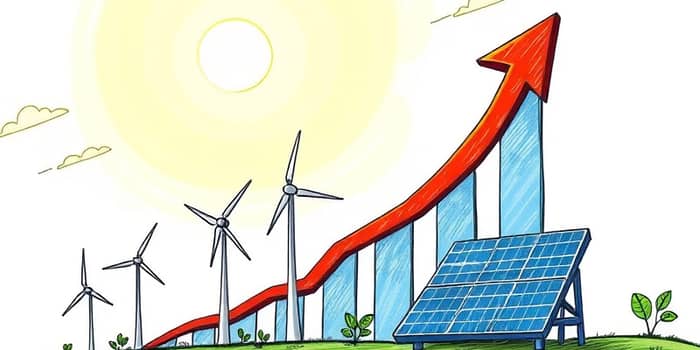
In mid-2025, the renewable energy sector stands at a crossroads. Record-breaking investments and ambitious policy targets have fueled unprecedented growth, while cost dynamics and market volatility pose new questions for potential investors. This comprehensive guide explores industry trends, financial considerations, key players, and long-term outlooks to help you decide whether renewable energy stocks belong in your portfolio today.
Recent data underscore the explosive expansion of clean energy across the United States. In 2024, renewables accounted for an astounding 99% of new capacity additions. This remarkable statistic highlights not only the growing demand for low-carbon power but also the rapid deployment of solar and wind technologies, often paired with battery storage to ensure reliability. As 2025 unfolds, industry forecasts anticipate a continuation of this trend, driven by robust corporate and government commitments around the globe.
For investors, understanding the evolving cost structure of renewable projects is crucial. After a temporary uptick in 2023—driven by supply chain disruptions, labor shortages, and elevated financing costs—the long-term trajectory for solar and wind remains in decline. Thanks to provisions in the U.S. Inflation Reduction Act (IRA), enhanced tax credits extend through 2032, making new wind and solar initiatives more competitive against conventional energy sources.
Meanwhile, energy sector stocks have experienced moderate gains. A recent 2.9% increase in overall sector performance over 30 days masks striking variances: certain names have delivered over 25% returns in the same period, reflecting the sector’s inherent volatility and opportunity.
Identifying industry leaders can help investors pinpoint where to focus research. Below is a snapshot of prominent companies shaping the renewable energy landscape in 2025:
Among these, NextEra Energy reported a 5% revenue increase year-over-year in Q2 2024, driven by strategic acquisitions and project expansion. Such performance metrics are essential when weighing potential entries into the sector.
Several catalysts converge to bolster renewable energy adoption worldwide. The proliferation of AI and data centers dramatically increases electricity consumption, prompting tech giants to secure green power supplies via long-term agreements. Corporate sustainability targets further intensify demand, independent of federal incentives. Simultaneously, advances in battery storage technology are reducing the intermittency challenge, making renewables more dispatchable and reliable.
Despite the promising outlook, investors must navigate several headwinds. Rising inflation and interest rates have inflated capital costs, particularly for offshore wind. Price volatility in commodity markets can spill over to energy equities, amplifying downside risk. Policy shifts remain a wildcard: changes in subsidies or regulatory frameworks could alter project viability, requiring continuous monitoring of legislative developments across key markets.
Over the past decade, global investments in renewable energy (excluding large hydropower) totaled $2.7 trillion, led by China ($818 billion) and the U.S. ($392 billion). As of 2022, renewables supply nearly 28% of worldwide electricity—a dramatic rise from 19% in 1990. This steady growth reflects both technological maturation and intensified climate-related incentives. Experts project that renewable capacity and associated investments will continue to outpace fossil fuels, cementing the sector’s strategic importance for decades to come.
Deciding whether to invest in renewable energy stocks today depends on individual risk tolerance, investment horizon, and portfolio diversification goals. Those seeking long-term growth in alignment with sustainable goals may find compelling entry points, particularly in companies with solid balance sheets and proven project pipelines. However, short-term traders should remain cautious of market swings and policy changes that could affect stock performance.
Ultimately, renewable energy offers a unique blend of financial opportunity and environmental impact. By combining thorough research, strategic allocation, and vigilance over evolving trends, investors can position themselves to harness the sector’s transformative potential.
References













